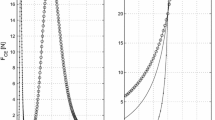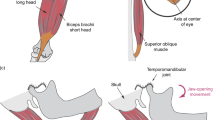Abstract
The structure of a skeletal muscle is dominated by its hierarchical architecture in which thousands of muscle fibres are arranged within a connective tissue network. The single muscle fibre consists of many force-producing cells, known as sarcomeres, which contribute to the contraction of the whole muscle. There are a lot of questions concerning the optimisation of muscle strength and agility. To answer these questions, numerical testing tools, e.g. in the form of finite element models can be an adequate alternative to standard experimental investigations. The present approach is crucially based on the use of the finite element method. The material behaviour of the muscle is additively split into a so-called active and a passive part. To describe the passive part special unit cells consisting of one tetrahedral element and six truss elements have been derived. Embedded into these unit cells are non-linear truss elements which represent bundles of muscle fibres. Besides the representation of the material model, this contribution focuses on the application to anatomically based 3D problems, as the animal soleus muscle of the rat.
Similar content being viewed by others
References
Ariano M.A., Armstrong R.B., Edgerton V.R.: Hindlimb muscle fiber populations of five mammals. J. Histochem. Cytochem. 21(1), 51–55 (1973)
Blemker S.S., Pinsky P.M., Delp S.L.: A 3d model of muscle reveals the causes of nonuniform strains in the biceps brachii. J. Biomech. 38, 657–665 (2005)
Blix M.: Die Länge und die Spannung des Muskels. Skand. Arch. Physiol. 3, 295–318 (1894)
Böl M., Reese S.: Finite element modelling of rubber-like polymers based on chain statistics. Int. J. Solids Struct. 43, 2–26 (2006)
Böl M., Reese S.: A new approach for the simulation of skeletal muscles using the tool of statistical mechanics. Mater. Sci. Eng. Technol. 38, 955–964 (2007)
Böl M., Reese S.: Micromechanical modelling of skeletal muscles based on the finite element method. Comput. Methods Biomech. Biomed. Eng. 11, 489–504 (2008)
Böl, M., Reese, S., Parker, K.K. Kuhl, E.: Computational modeling of muscular thin films for cardiac repair. Comput. Mech. http://www.springerlink.com/content/q83035412861087q/ (2008)
Edström L., Larsson L.: Effects of age on contractile and enzyme-histochemical properties of fast- and slow-twitch single motor units in the rat. J. Physiol. 392, 129–145 (1987)
Fung Y.C.: Biomechanics: Mechanical Properties of Living Tissue. Springer, New York (1993)
Gordon A.M., Huxley A.F., Julian F.J.: The variation in isometric tension with sarcomere length in vertebrate muscle fibres. J. Physiol. 184, 170–192 (1966)
Hill A.V.: The maximum work and mechanical efficiency of human muscles, and their most economical speed. J. Physiol. 56, 19–41 (1922)
Hill A.V.: The heat of shortening and the dynamic constants of muscle. Proc. R. Soc. Lond. B 126, 136–195 (1938)
Huxley A.F.: Muscle structure and theories of contraction. Prog. Biophys. Biophys. Chem. 7, 255–318 (1957)
Kernell D., Eerbeek O., Verhey B.A.: Relation between isometric force and stimulus rate in cat’s hindlimb motor units of different twitch contraction time. Exp. Brain Res. 50, 220–227 (1983)
Magnusson S.P., Hansen P., Aagaard P., Brønd J., Dyhre-Poulsen P., Bojsen-Moller J.: Differential strain patterns of the human gastrocnemius aponeurosis and free tendon, in vivo. Acta Physiol. Scand. 177, 185–195 (2003)
Pette D., Staron R.S.: Cellular and molecular diversities of mammalian skeletal muscle fibers. Rev. Physiol. Biochem. Pharmacol. 116, 1–47 (1990)
Schmalbruch H.: Skeletal Muscle. Springer, Berlin (1985)
Stark, H.: Die 3D-Architektur der Muskelfaszikel in ausgewählten Muskeln und ihre Relevanz zur Kraftentwicklung. Ph.D. thesis, Friedrich-Schiller-Universität Jena (2008)
Staron R.S., Kraemer W.J., Hikida R.S., Fry A.C., Murray J.D., Campos G.E.R.: Fiber type composition of four hindlimb muscles of adult Fisher 344 rats. Histochem. Cell Biol. 111, 117–123 (1999)
Taylor A.M., Steege J.W., Enoka R.M.: Motor-unit synchronization alters spike-triggered average force in simulated contractions. J. Neurophysiol. 88, 265–276 (2002)
Tsui C.P., Tang C.Y., Leung C.P., Cheng K.W., Ng Y.F., Chow D.H.K., Li C.K.: Active finite element analysis of skeletal muscle-tendon complex during isometric, shortening and lengthening contraction. Biomed. Mater. Eng. 14, 271–279 (2004)
van Leeuwen J.L.: Muscle function in locomotion. In: Alexander, R.M. (eds) Mechanics of Animal Locomotion, pp. 191–249. Springer, Berlin (1992)
Author information
Authors and Affiliations
Corresponding author
Additional information
An erratum to this article is available at http://dx.doi.org/10.1007/s00419-011-0575-3.
Rights and permissions
About this article
Cite this article
Böl, M. Micromechanical modelling of skeletal muscles: from the single fibre to the whole muscle. Arch Appl Mech 80, 557–567 (2010). https://doi.org/10.1007/s00419-009-0378-y
Received:
Accepted:
Published:
Issue Date:
DOI: https://doi.org/10.1007/s00419-009-0378-y




